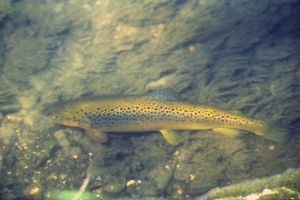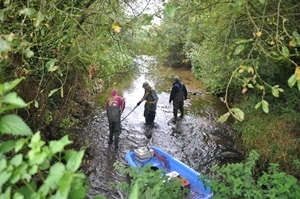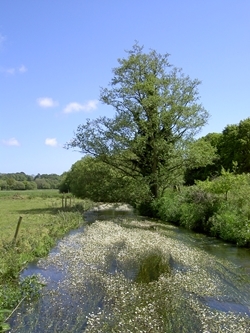Key points
- Salmon and trout populations are declining, perhaps partly because of changes to their freshwater habitats.
- Understanding which river characteristics provide better habitat for young salmon and trout can help river managers to maintain healthy populations of these fishes.
- This study looked at different aspects of the river and how these were associated with salmon and trout numbers.
- Greater numbers of salmon were found at sites that had more plants in the river, and that were near to spawning areas.
- Greater numbers of trout were found at sites with more variety in the speed of water.
- Managers can help maintain habitat for juvenile salmon and trout by making sure there is enough vegetation in the river. This is particularly important in areas that are downstream from spawning sites.
- Sites with more suitable habitat can support greater numbers of young salmon and trout.
Background
 Salmon and trout are known as salmonids because they are part of the Salmonidae family of fish. Many salmonid species have a lifecycle that includes fresh water and saltwater. Generally, salmonids are born in rivers, then they migrate out to sea, where they grow from young fish into adults. They migrate back to rivers to breed (spawn).
Salmon and trout are known as salmonids because they are part of the Salmonidae family of fish. Many salmonid species have a lifecycle that includes fresh water and saltwater. Generally, salmonids are born in rivers, then they migrate out to sea, where they grow from young fish into adults. They migrate back to rivers to breed (spawn).
In recent years, some populations of salmonids have declined. Scientists think that this could be partly caused by impacts to rivers, such as pollution or barriers (e.g. weirs) in rivers. As a result, there is less suitable freshwater habitat available. When young salmonids hatch from eggs in the spawning sites (also known as redds), they swim downstream to suitable habitat where they can feed and grow. It is important to know what type of habitat is best for young salmonids so that river managers can develop effective management strategies to support them.
Relatively little is known about young salmonid habitat requirements in lowland rivers. These are more stable than upland rivers because they are fed by groundwater as opposed to rainwater.
The type of habitat used by young salmonids is described by river characteristics like water depth and speed, food availability and plant cover in the river. In this study, the authors looked at the relationships between river characteristics and the number of young Atlantic salmon and brown trout in a lowland river.
What they did
 This study was carried out in the River Frome in Dorset from 2015 to 2017. The River Frome is a lowland river that is home to Atlantic salmon and brown trout. Each August and September during the study, the scientists surveyed between 18 and 20 sites in the river. The sites were around 100m long and were chosen to represent the variety of river habitats (e.g. deep/shallow water, slow/fast water flows) found throughout the River Frome.
This study was carried out in the River Frome in Dorset from 2015 to 2017. The River Frome is a lowland river that is home to Atlantic salmon and brown trout. Each August and September during the study, the scientists surveyed between 18 and 20 sites in the river. The sites were around 100m long and were chosen to represent the variety of river habitats (e.g. deep/shallow water, slow/fast water flows) found throughout the River Frome.
In each survey, the authors counted young salmon and trout in each site. Fish were captured using electro-fishing, then measured to determine their age. When sampling was complete, fish were put back in the river in the same place that they were captured. At each site, multiple river characteristics were also measured. These included water depth, speed, and plant cover in the river, particularly water crowfoot (known as Ranunculus, a member of the buttercup family).
Salmon and trout are predatory fish and mostly feed on aquatic insect larvae. The authors used a technique called kick-sampling to measure the availability of food at each site. This technique involved kicking the riverbed to disturb aquatic insects, which can then be caught in a net as they float downstream. The authors identified the insect species and counted the number of species that the fish were likely to feed on.
As the survey sites were positioned all along the River Frome, the authors considered two additional factors that could influence the number of young fish in a site. Firstly, the authors recorded the position of the site within the river, because it is thought that more salmon use the lower part of the river, and more trout use the upper part. Secondly, the authors recorded whether the site was near to any spawning areas, because the sites closer to spawning areas were expected to have more young fish.
The authors built statistical models to identify which river characteristics had the strongest relationship with numbers of young salmon and trout.
What they found
This study looked at the number of young salmon and trout between 2015 and 2017. Every year there were more salmon than trout, but during 2016 there were very low numbers of both species. This was possibly due to an unusually warm and wet winter in 2015-2016, which is thought to have caused many salmonid eggs to die.
The authors wanted to look specifically at the importance of river characteristics in typical river conditions, so they also analysed the data without the information collected in 2016.
Using only the data from 2015 and 2017, the results showed that there were more young salmon in sites:
- With more plant cover in the river
- Closer to spawning areas
- Positioned in the lower part of the river
Whereas more young trout were found in sites that had more variable water speed, i.e. a mixture of fast and slow flows.
What does this mean?
 Young salmon and trout have different habitat requirements, yet in-river plants are perhaps important for both species. More young salmon were found in sites with higher plant cover. This could be because plant cover provides protection from predators and this allows young salmon to focus on feeding. More young trout were found in sites with greater variation in water speed. A mixture of water speeds allows fish to use less energy to find and capture their prey. Fish rest in slow water, and nearby areas of fast water bring insect prey close by. The variation in water speed in lowland rivers is created by in-river plants. Water slows down within areas of vegetation, and is forced around the outside of the plant, creating areas of fast flowing water nearby.
Young salmon and trout have different habitat requirements, yet in-river plants are perhaps important for both species. More young salmon were found in sites with higher plant cover. This could be because plant cover provides protection from predators and this allows young salmon to focus on feeding. More young trout were found in sites with greater variation in water speed. A mixture of water speeds allows fish to use less energy to find and capture their prey. Fish rest in slow water, and nearby areas of fast water bring insect prey close by. The variation in water speed in lowland rivers is created by in-river plants. Water slows down within areas of vegetation, and is forced around the outside of the plant, creating areas of fast flowing water nearby.
Managers can help maintain plant communities in rivers by avoiding excessive cutting of aquatic plants. This action should create good habitat for young salmonids. It will be particularly effective in areas close to spawning sites. Managers can also help aquatic plants access sunlight by preventing overgrowth of vegetation on riverbanks.
Read the original abstract
Marsh, JE, Lauridsen, RB, Gregory, SD, et al. Above parr: Lowland river habitat characteristics associated with higher juvenile Atlantic salmon (Salmo salar) and brown trout (S. trutta) densities. Ecol Freshw Fish. 2019; 00: 1– 15.